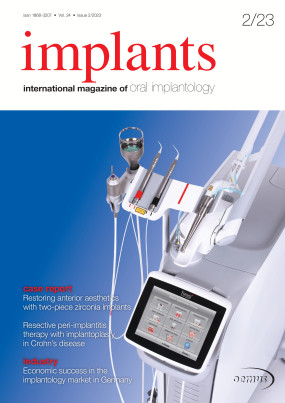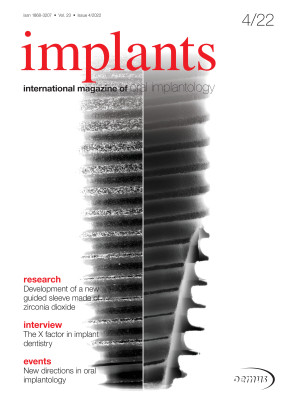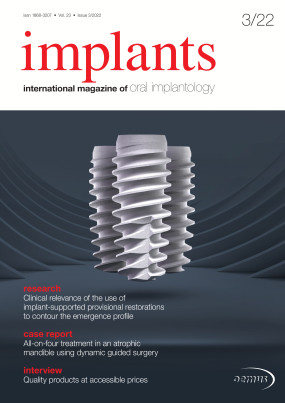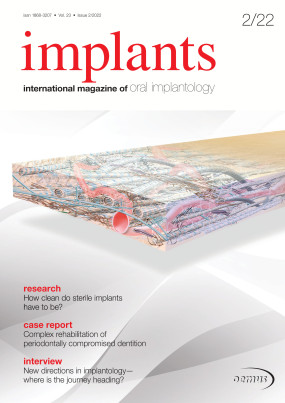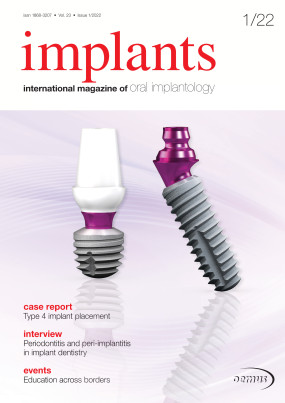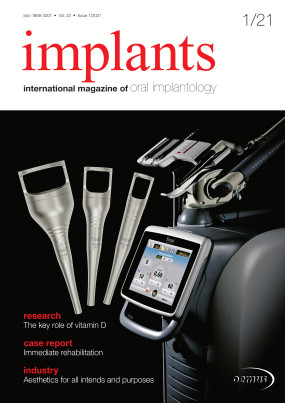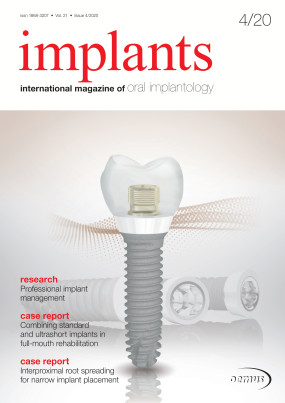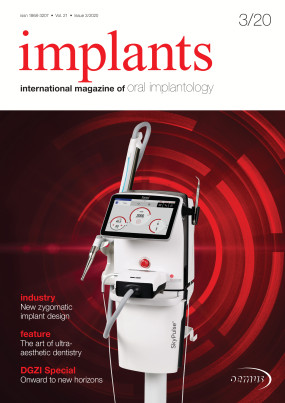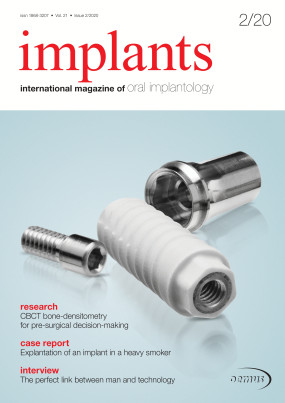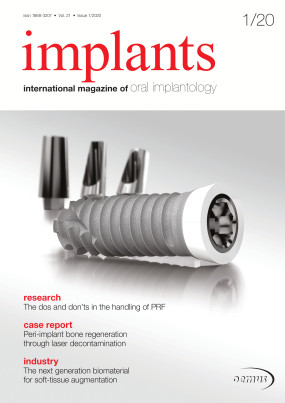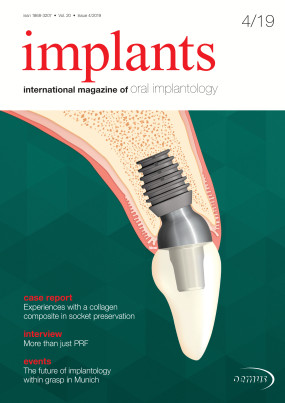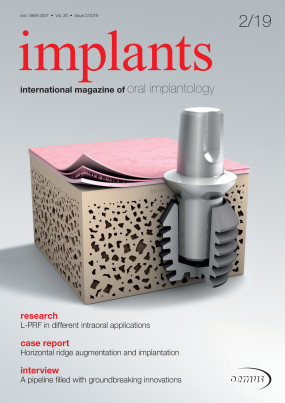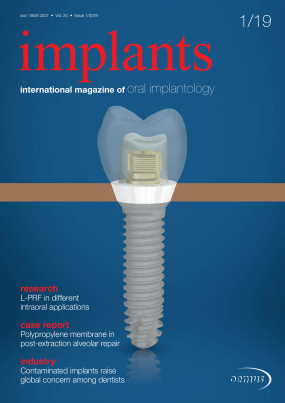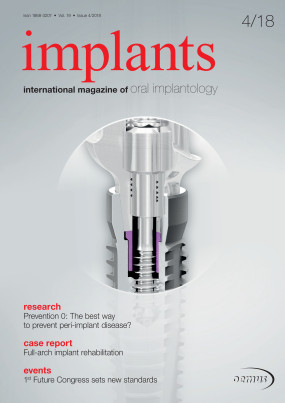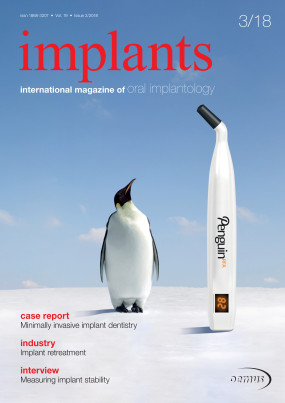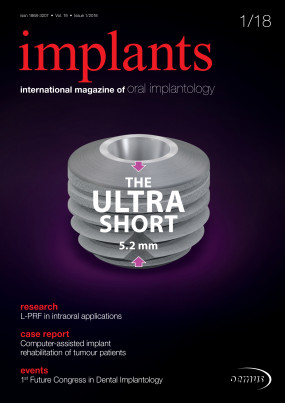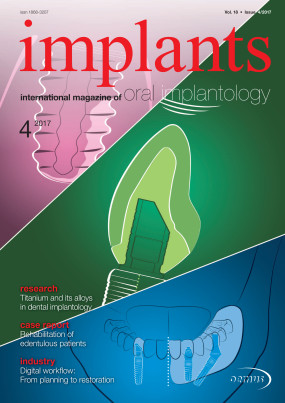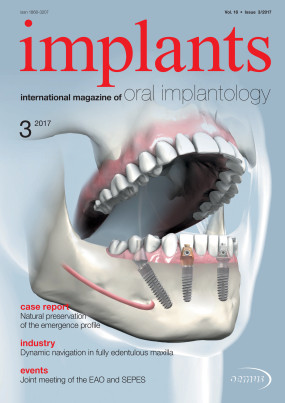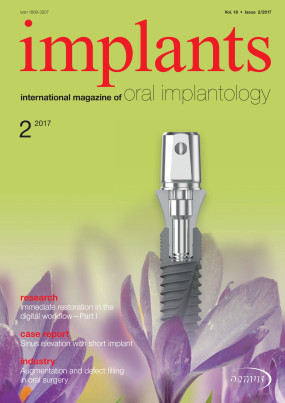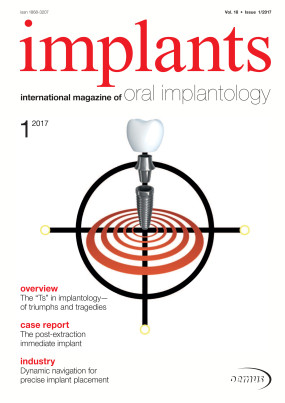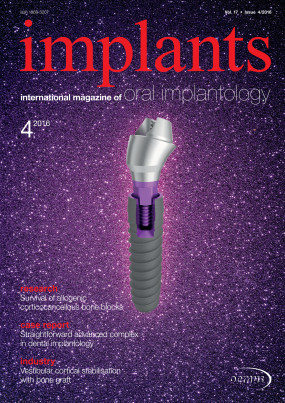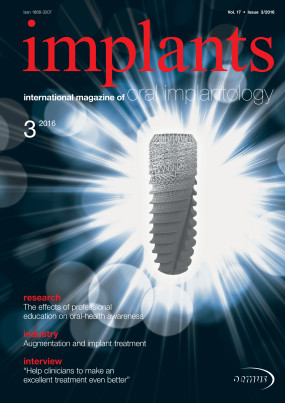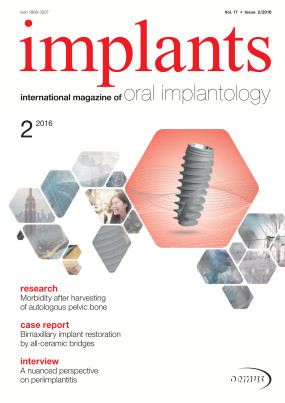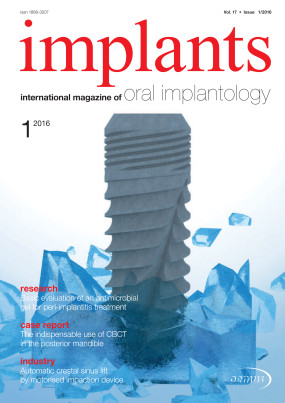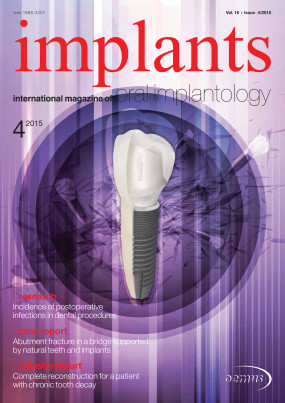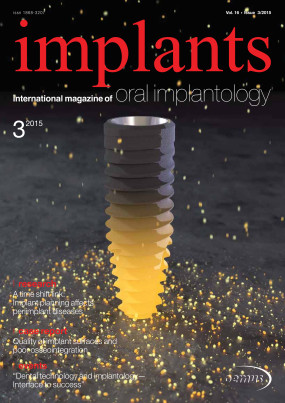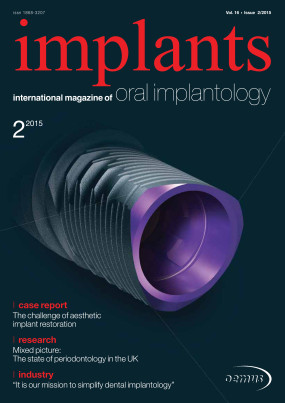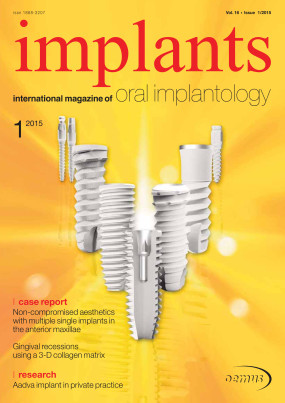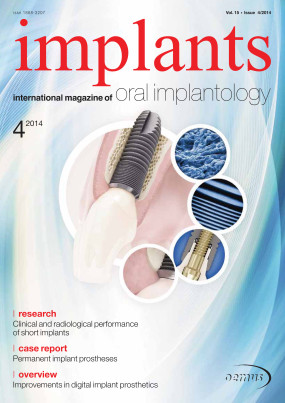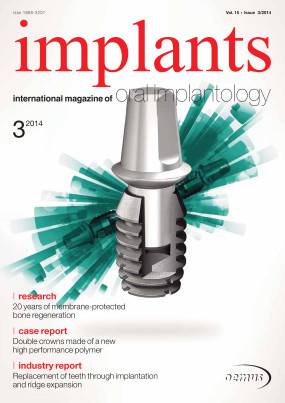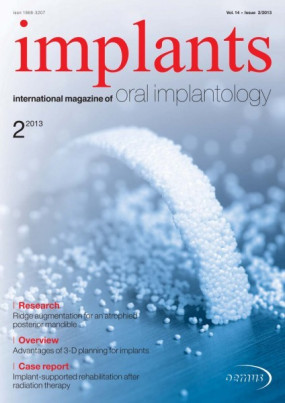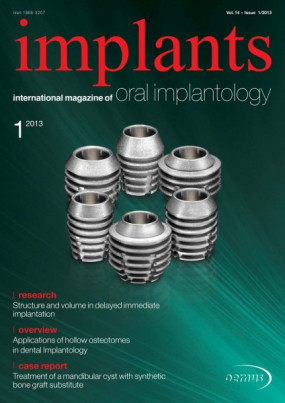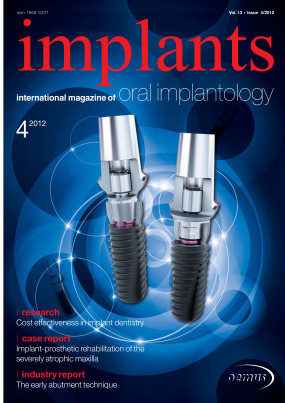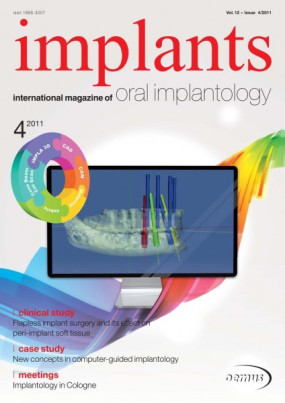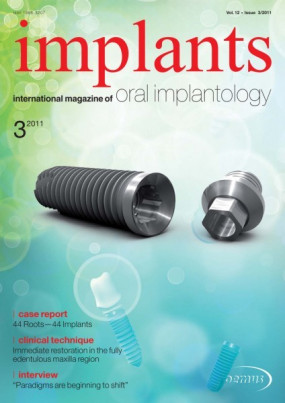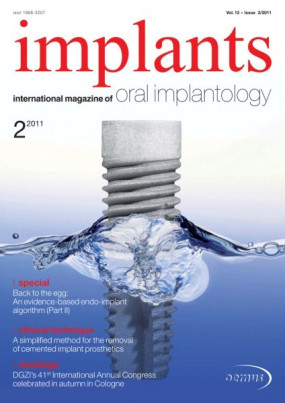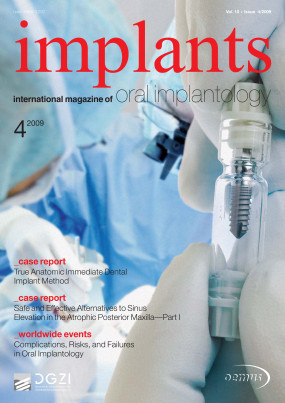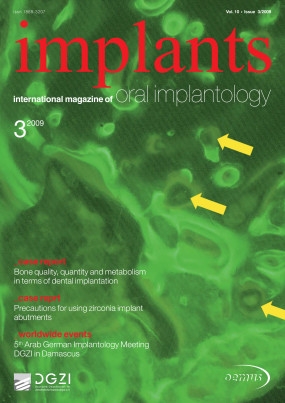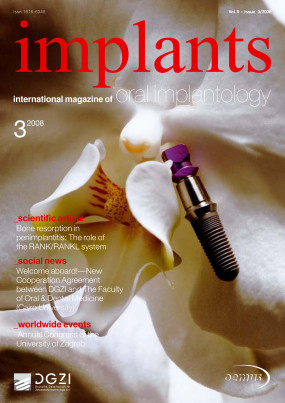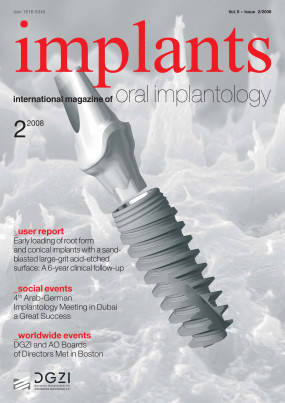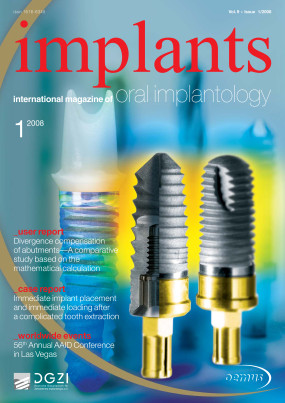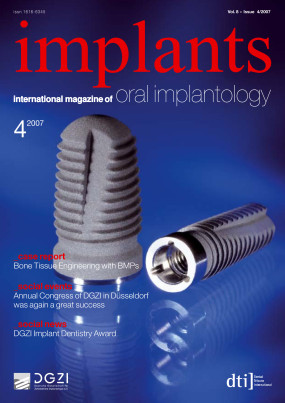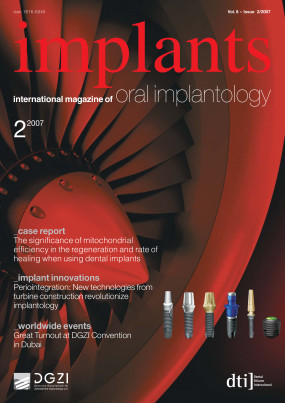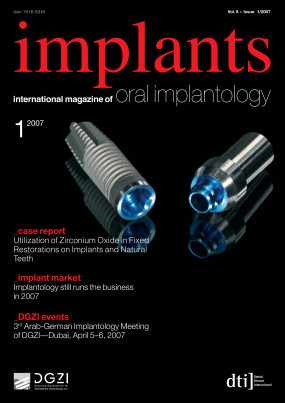Inhaltsverzeichnis
3
Editorial: “The bone sets the tone and the tissue is the issue”
Dr Rolf Vollmer, First Vice President and Treasurer of DGZI
The quotation by Dennis Tarnow should be the benchmark for implant treatment. Advancing knowledge and the possibilities of digital techniques are making it increasingly possible to develop the ideal implant treatment plan effectively. This makes it all the more important to work together with your dental technician as a team in order to analyse the examination findings exactly and to implement them in the best possible way according to the patient’s desires...
6
How clean do sterile implants have to be? Analysis and clinical relevance of factory-related contaminations
Dr Dirk U. Duddeck, Germany
The initial phase of the biological response to a placed implant is primarily determined by the implant’s surface characteristics. The properties of any implant surface are an essential factor of its non-irritant integration into surrounding tissue structures.1 Undisturbed osteoblast proliferation and osteoblast differentiation at the implant surface depend decisively on the microstructure of the surface.2 Since the 1980s, however, there have also been growing demands for fl awless cleanliness of the implant systems used.3 In this context, it is a logical step not only to look at current analytical techniques but also to take a critical look at the clinical signifi cance of avoidable contamination on brand-new sterile-packaged implants...
12
During the complete rehabilitation of the severely periodontally compromised dentition of a 69-year-old female patient, the treatment team had to consider various aspects in making treatment decisions for ethical as well as forensic reasons. The patient wanted a functional and aesthetic restoration of the upper and lower jaws that would be stable in the long term and make use of her own teeth that were worth preserving. Thus, the questions arose as to what her potential risk of loss of implants because of her previous periodontal disease would be and whether the intervention could achieve the most permanent improvement possible in her oral health-related quality of life.1 The patient’s age and state of health had to be assessed in terms of how long her manual dexterity for oral hygiene would be maintained...
16
Fabrication of a screw-retained implant-supported maxillary restoration: A completely digital workflow
Prof. Sven Rinke & Dr Holger Ziebolz, Germany
The fabrication of implant-supported full-arch restorations requires maximum precision, whether employing analogue or digital impressions, to achieve a perfect and passive fit. In this context, the application of intra-oral scanners has been a topic of much debate. Through the development of new scanner systems and specially adapted scan gauges for these indications as well as the application of appropriate scanning techniques, these systems allow for improved precision. The EVO+ system (Modern Dental Europe) incorporates these optimisation strategies into a purely digital workflow for the fabrication of removable and fixed implant-supported restorations in edentulous patients...
24
Rehabilitation of a failing central incisor: A periodontal and restorative success formula
Dr Rita Singh, Nepal
Rehabilitation in the anterior zone with implant-supported restorations is a daunting task. Implant-supported rehabilitation in the anterior maxilla requires seamless merging of the restoration with the existing gingival architecture. Therefore, prosthetically driven implant placement is of utmost importance in achieving the aesthetic goal. Implant success is not limited to osseointegration alone but is mainly dependent on the aesthetic outcome. Another important factor influencing success of the procedure is the quality of hard and soft tissue available at the time of treatment planning. This periodontal assessment is the crux of aesthetic zone management in cases which require augmentation procedures with immediate implantation. The hard and soft tissue form the peri-implant seal which is crucial for the long-term success of the implant restoration. Immediate implantation has become the preferred option for cases in the anterior zone, as it prevents post-extraction ridge collapse and hence maintains optimum bone and soft-tissue quantity and quality for favourable outcomes. Immediate provisionalisation of the implant maintains acceptable function and aesthetic appearance simultaneously, providing a template for soft-tissue contouring and maturation until a definitive restoration can be integrated. The implant also serves as a placeholder to prevent migration of neighbouring teeth and extrusion of opposing teeth. Favourable implant success, peri-implant tissue response and aesthetic outcomes can be achieved with immediately placed and provisionalised maxillary anterior single implants.1 A favourable visual result is a combination of a well-planned and executed surgical technique along with good prosthetic choices and operator skill. The following case report showcases the complete rehabilitation of an ailing maxillary central incisor with an implant-supported restoration...
28
Interdisciplinary approach to treating the aesthetic zone in a young patient: A clinical case report
Dr David Garcia Baeza, Spain
Implant dentistry demands an interdisciplinary approach that incorporates all of dentistry’s knowledge, experience and skills to aid in delivering a comprehensive treatment plan. Aesthetics in dentistry is frequently the motivation for seeking dental care and treatment. In my private practice, it is usual to receive patients who demand natural-looking results. Before beginning therapy, our team examines all aspects that may influence the treatment outcome. With growing patient expectations, today, we cannot focus only on one tooth. That is the reason why an interdisciplinary approach involving all dental specialties should be employed to create a complete treatment plan and will produce undoubtedly better results...
34
Prosthetic rehabilitation with short GTB implants: A case report with nine-year follow-up
Dr Nicola Vanuzzo, Italy
Implant-prosthesis systems have continuously evolved regarding osseointegration, implant size reduction and long-term predictability results, guided by the stability and absence of inflammation of the peri-implant tissue. The following case report demonstrates the results that are obtainable today...
38
The following case report, presented in images, concerns the treatment of a 55-year-old male patient, who complained about the poor retention of his maxillary complete denture and requested a fixed solution (Figs. 1 & 2). The dual-scan protocol was used to visualise bone, soft-tissue thickness and denture position in Simplant software (Dentsply Sirona; Fig. 3). Four DS PrimeTaper EV 3.6 mm diameter implants (Dentsply Sirona) were planned according to the position of his denture and four Multibase abutments (Dentsply Sirona) were visualised accordingly. Prior to surgery, intra-oral scans of the edentulous upper and the dentate lower jaw were performed. The denture was used first as a surgical guide and then as a provisional prosthesis, after removing the palate (Fig. 4). Immediately after implant placement (Figs. 5–10), abutment position was registered with an intraoral scan (Figs. 11–13). A definitive prosthesis consisting of an Atlantis BridgeBase (Dentsply Sirona; Fig. 14) and zirco- nia was placed eight weeks after implant insertion (Figs. 15–18)...
40
Delayed immediate implant placement and direct soft-tissue management: A 12-month follow-up
Dr Haki Tekyatan, Germany
This follow-up after 12 months concerns the current clinical and radiological condition of a case previously documented in a published report,1 more specifically an implantological treatment in region #12. In summary, endodontic treatment of tooth #12 had failed, the tooth was not worth preserving and it was thus extracted in a minimally invasive manner. Local bone and alveolar management were carried out using bio-functionalised (injectable platelet-rich fibrin or A-PRF) CERASORB Foam (curasan), a biomimetic, regenerative -tricalcium phosphate collagen matrix. Six weeks after the alveolar management, delayed immediate implantation was carried out using a surgical guide and implant position was confirmed via an intraoperative scan. The scan was used to produce a new, special individualised PEEK healing abutment. Another six weeks later, implant exposure and direct soft-tissue management took place in the healing phase with the special PEEK healing abutment. Finally, the fitting of a ceramic crown was carried out...
42
New directions in implantology—where is the journey heading?
An interview with Dr Georg Bach, President of DGZI, Germany
Like in our own lives, no path is straight in implantology. Again and again, there are forks in the road and one is faced with the decision of whether to go left or right or perhaps continue straight ahead. In everyday practice, new treatment methods, innovative implantology concepts and new materials form these different paths. The 51st international annual congress of the German Association of Dental Implantology (DGZI) will take participants on a journey on 30 September and 1 October in Berlin in Germany, showing them which of the many paths ultimately lead to successful treatment. In this interview with DGZI President Dr Georg Bach, readers can find out what they can particularly look forward to this year...
46
An outstanding dentist and speaker, innovative and quality products developed and made in Germany, a brand-new implantology training centre with a clinic in the heart of Europe in a region rich in beauty, history and culinary delights— that is the secret of success of the master class in implan- tology, one of the best dental training courses in Germany...
48
With its ONLINE Campus, the DGZI already adjusted the specialist theoretical curricular training two years ago to a contemporary and, above all, convenient solution for the participants. After the market launch of the German DGZI ONLINE Campus, the English version for international DGZI members followed in 2020...









